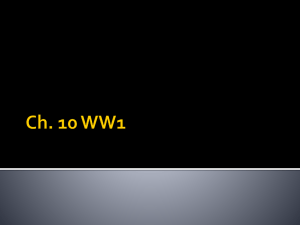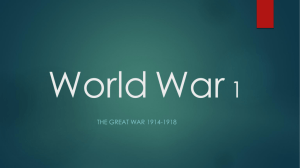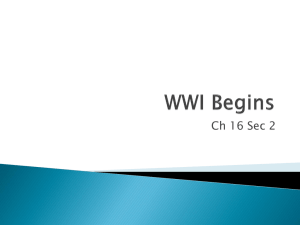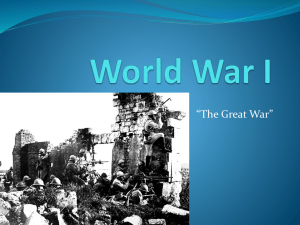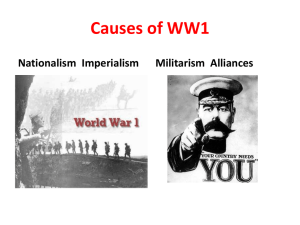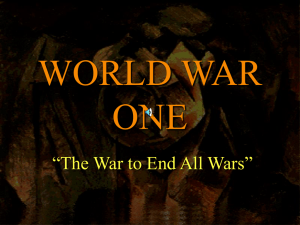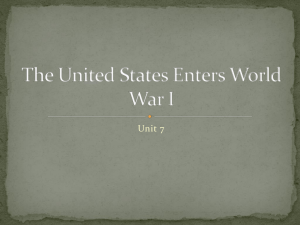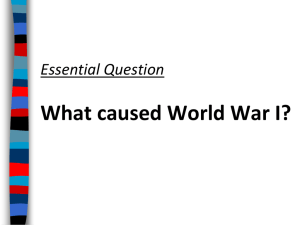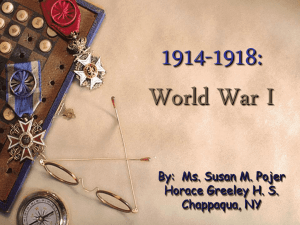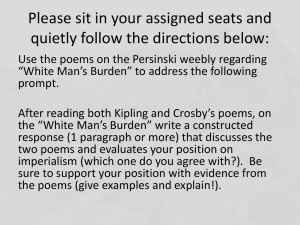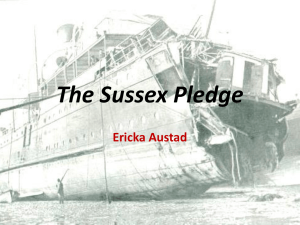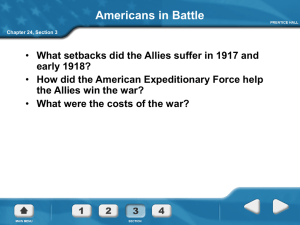The War to End All Wars: World War I
advertisement
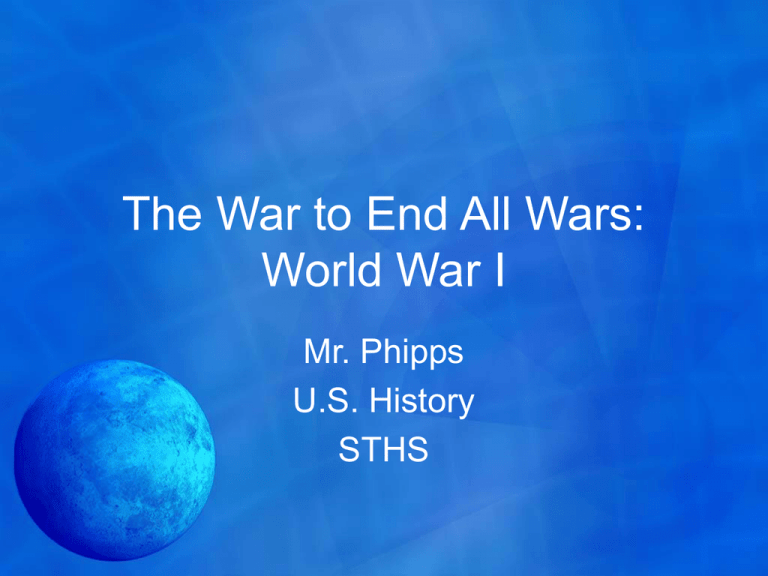
The War to End All Wars: World War I Mr. Phipps U.S. History STHS California State Standards 11.4.5--Analyze the political, economic, and social ramifications of World War I on the home front. Questions • • • • How was World War I different than previous wars? What were the long term causes of the Great War? What were the immediate causes of the Great War? What were the main strategies and techniques used during the war? • How did military technology change? • Why did the U.S. enter the war? Why did the U.S. enter the war so late? • What position in the global community did the U.S. have at the conclusion of the war? #1 On separate paper, answer the following questions Vocabulary • Total War: A war of attrition, in which compromise is not sought, no deals • • • • • • are accepted other than total surrender; A war in which armies and civilians work together in the war effort; A war that affects all aspects of society: farmland, military, cities, etc., Schlieffen Plan: German military strategy to invade France first, then Russia; Reason--Russia would be unable to mobilize due to lack of railroads Mobilization: A nation’s effort to prepare for war, requires the development of military technology, training of armies, and deployment of armies. Nationalism: Extreme pride in one’s country; The belief that one’s country is superior (in all ways) to all other countries. Militarism: A national desire to prove military superiority. Imperialism: A country’s agenda to take over other countries for land, resources, etc., Alliances: A relationship one country has with another, usually for mutual protection and benefit. The Great War: In a Nutshell • The first war to include multiple countries • The first war to include countries from Europe, the Middle East, and Asia--drawn together by complex alliance system • The first “modern” war • Use of modern technology: first airplanes, first tanks, first gas attack • Most dead in a single battle • The first “European” war the U.S. fought in • Largest mobilization effort, to date The Great War: The Numbers A llied Powers Rus s ia Franc e Britis h E mpire I taly U nited S tates J apan Romania S erbia Belgium G reec e P ortugal M ontenegro Total Cent ral Powers G ermany A us tria- H ungary T urkey Bulgaria Total Grand Total Mobilized KIA W ounded Prisoners/MNIA Casualt ies Casualt ies & 1 2 ,0 0 0 ,0 0 0 1 ,7 0 0 ,0 0 0 4 ,9 5 0 ,0 0 0 2 ,5 0 0 ,0 0 0 9 ,1 5 0 ,0 0 0 7 6 .3 8 ,4 1 0 ,0 0 0 1 ,3 5 7 ,8 0 0 4 ,2 6 6 ,0 0 0 5 3 7 ,0 0 0 6 ,1 6 0 ,8 0 0 7 6 .3 8 ,9 0 4 ,4 6 7 9 0 8 ,3 7 1 2 ,0 9 0 ,2 1 2 1 9 1 ,6 5 2 3 ,1 9 0 ,2 3 5 3 5 .8 5 ,6 1 5 ,0 0 0 6 5 0 ,0 0 0 9 4 7 ,0 0 0 6 0 0 ,0 0 0 2 ,1 9 7 ,0 0 0 3 9 .1 4 ,3 5 5 ,0 0 0 1 2 6 ,0 0 0 2 3 4 ,3 0 0 4 ,5 0 0 3 6 4 ,8 0 0 8 .2 8 0 0 ,0 0 0 300 907 3 1 ,2 1 0 0 .2 7 5 0 ,0 0 0 3 3 5 ,7 0 6 1 2 0 ,0 0 0 8 0 ,0 0 0 5 3 5 ,7 0 6 7 1 .4 7 0 7 ,3 4 3 4 5 ,0 0 0 1 3 3 ,1 4 8 1 5 2 ,9 5 8 3 3 1 ,1 0 6 4 6 .8 2 6 7 ,0 0 0 1 3 ,7 1 6 4 4 ,6 8 6 3 4 ,6 5 9 9 3 ,0 6 1 3 4 .9 2 3 0 ,0 0 0 5 ,0 0 0 2 1 ,0 0 0 1 ,0 0 0 1 7 ,0 0 0 1 1 .7 1 0 0 ,0 0 0 7 ,2 2 2 1 3 ,7 5 1 1 2 ,3 1 8 3 3 ,2 9 1 3 3 .3 5 0 ,0 0 0 3 ,0 0 0 1 0 ,0 0 0 7 ,0 0 0 2 0 ,0 0 0 40 42,188,810 5,152,115 12,831,004 4,121,090 22,104,209 52.3 1 1 ,0 0 0 ,0 0 0 7 ,8 0 0 ,0 0 0 2 ,8 5 0 ,0 0 0 1 ,2 0 0 ,0 0 0 22,850,000 1 ,7 7 3 ,7 0 0 1 ,2 0 0 ,0 0 0 3 2 5 ,0 0 0 8 7 ,5 0 0 3,386,200 4 ,2 1 6 ,0 5 8 3 ,6 2 0 ,0 0 0 4 0 0 ,0 0 0 1 5 2 ,3 9 0 8,388,448 1 ,1 5 2 ,8 0 0 2 ,2 0 0 ,0 0 0 2 5 0 ,0 0 0 2 7 ,0 2 9 3,629,829 7 ,1 4 2 ,5 5 8 7 ,0 2 0 ,0 0 0 9 7 5 ,0 0 0 2 6 6 ,9 1 9 15,404,477 65,038,810 8,538,315 21,219,452 7,750,919 37,508,686 6 4 .9 90 3 4 .2 2 2 .2 67.4 57.6 #2 • Identify two long range causes of World War I. • Identify two short range causes of World War I. The Long Term Causes of WWI • • • • Nationalism Imperialism Militarism Alliances #3 Rate the importance of each: 1-4 (1=most important factor) Nationalism • Causes – The belief that each country was culturally superior to any other countries – Evident in the competition for resources – Long term cultural hatred (the Russians hated the Germans, the Bosnians hated the Serbs, the Ottomans hated the Greeks, etc) – Based on social customs, religion, cultural accomplishments – Unified people • Effects – Resulted in a global effort to prove superiority – Evident in growth of military, the growth of industry, the acquisition of territories – Resulted in large scale international tension #4 In what ways does the U.S. illustrate nationalism? How is nationalism positive? Negative? Imperialism • Causes – Quest for resources in order to increase national economy – Prove superiority to other countries #5 How did the U.S. benefit from imperialism during the late 1800s? • Effects – Resulted in competition over territorial acquisition – Resulted in long-term aggression over border disputes, natural resources, and new markets – Examples: • France v. Germany over Alsace-Lorraine • Austria-Hungary v. Russia over Balkans #6 What changed between 1890-1910? How did this contribute to international tension? Militarism • Causes – Competition for military superiority – Use of industry to create military technology • Effects – Resulted in an “arms race” – Resulted in the creation of new deadly war machines The Alliance System • The Triple Alliance – A.K.A. The Central Powers, “The Bad Guys”, “The Huns” – Formed by secret alliance treaties in 1887 – Purpose to take back land from France and balance power – Included Austria-Hungary, Germany, and the Ottoman Empire • The Triple Entente – A.K.A. The Allies, The “Good Guys”, “Tommies” (G.B.), “Doughboys” (U.S.A.) – Formed by treaty in 1907 – Purpose to challenge German naval control – Included Great Britain, France, Russia, Serbia, and the U.S.A. #7 How does this cartoon describe the alliance system before the war? Immediate Causes of WWI • The Allies – Great Britain, France, Russia, and Serbia • The Central Powers – Austria-Hungary, Germany, the Ottoman Empire •All countries are struggling for world domination. •All countries consider themselves the most able to rule the world. •All countries are bound to each other through complex alliances. •All countries are unified in their support for the war. •All countries are fully armed and hate every other country. The Balkans The Snowball Effect… • In the spirit of nationalism and selfdetermination, the small country of Serbia seeks independence from Bosnia, the Ottoman Empire, and Austria-Hungary. • The region, the Balkans, is THE highway for all trade and communication between Europe and Asia. • The Balkans is a region ALL COUNTRIES want to control. • The Balkans is convulsed by civil war. Gathering Momentum… • On June 28, 1914, Gavrilo Princip, a Serbian nationalist and member of the Black Hand, kills Archduke Franz Ferdinand and his family while they are supervising a military exercise in Sarajevo. • Targeting the heir to the Austrian-Hungarian throne, Princip attempts to declare Serbia independence. Degenerating to War: The Fall of 1914 • June 28, 1914: Austria-Hungarian Archduke assassinated • July 28, 1914: Austria-Hungary mobilizes army and declares war on Serbia • July 31, 1914: Russia mobilizes army against AustriaHungary to protect Serbian ally • August 1, 1914: Germany declares war on Russia • August 3, 1914: Germany declares war on France • August 4, 1914: Germany invades Belgium • August 4, 1914: Angered, Great Britain declares war on Germany • August 6, 1914: Austria-Hungary declares war on Russia The Funeral Procession So What? • Russia rushes to protect its ally • Germany declares war on everyone • Germany engages Schlieffen Plan, invading France first • All sides expect a short war, over by Christmas 1914 The Great War Begins • Sept. 5-10, 1914: The First Battle of the Marne – Germany pushes through Belgium to attack France at the Marne River, outside of Paris – Quickly mobilizing, France sends 600 taxicabs full of soldiers to fight back – The first trenches are dug, and France forces Germany to retreat – Effects: • Russia quickly mobilizes and attacks Germany on the Eastern Front • Shows Germany that the Schlieffen Plan would not work • Both sides dig in for long, defensive war How did it happen? • Bad Directions!!! – A German officer, taking a wrong turn out of the General’s camp drove into a French patrol and was murdered. – In the officers bag: a map which showed the exact location of German troops and the direction of the next day’s offensive. Stalemate • The Tactics of Trench Warfare – Generals were unprepared for the development of trench warfare: their training was in army mobility – Main strategy: • To use a combination of heavy artillery and MORE MEN to break the trench line • First, to use artillery to “soften up” the enemy and destroy barbed wire • Second, to fix bayonets and lead a charge across No Man’s Land • Third, to kill the enemy in hand-to-hand combat. – Exceptions, by mutual consent: • No bombing the latrines. • No bombing before breakfast. • No bombing on major holidays. Life in the hole • The Equipment: – 1 rifle, 1 bayonet, 170 rounds of ammo, 1 gas mask, 1 shovel, wire cutters, a full water bottle, food rations, extra clothing, medical supplies, portable cooking stove and fuel, personal belongings • Total Weight: 60 lbs. The Trench System Draw a sketch of the trench system in your notes. British trench, Thiepval Woods, France Write a Letter from the Trench • Directions: You will write a letter to your family or a friend from the trenches of the Western Front. The letter should be written so that your reader understands the stress and trauma of life in the trenches. You may use any notes to help you with this exercise. The letter should be AT LEAST one full page in length. • Time: February 7, 1915 • Place: Trenches outside Verdun, France • It should include: – The fear and anticipation you feel in the trenches – Your living conditions and daily life in the trenches – Any extraordinary events – Your morale and what you do to keep yourself entertained – It should be detailed, explicit, and graphic--use imagery!!! Total War: 1915 • January 1915: TOTAL WAR – Germans introduce poison gas to push the Western Front and break the Allied Defense. • May 7, 1915: H.S.S. Lusitania Sunk – En route from NYC to Britain, the British passenger ship is torpedoed by German UBoats. The Lusitania Incident • Germans accused the British that the Lusitania secretly carried guns and ammo to strengthen allied defense. • Germans accused the Americans for violating neutrality and selling the Brits war materials. • The H.S.S. Lusitania took 18 minutes to sink fully below water. • Due to the location of the explosion, the poor positioning of the lifeboats, and the confusion, 1195 people (over 60%) of the passengers died--128 of whom were American. • The Lusitania Incident resulted in angering the American public, calling for war. • Woodrow Wilson waited two years before declaring war. Why was the bombing of the Lusitania so scandalous? Was it fair for the Germans to torpedo it? Explain. The Battle for 1916: • The Battle of Verdun: February-December, 1916 – The longest battle of the WWI, lasting over 10 months. – Over 1 million dead on the battlefield – The battle became symbolic for WWI: French stubbornness to defend vs. German stubbornness to “bleed the French dry.” Total War at Verdun Battle of the Somme: 1916 • The Battle of the Somme: JulyNovember, 1916 – British offensive to relieve French allies at Verdun – British casualties on the first day: 20,000 – Most dead on both sides: 1 million A New Technology Cyanide/Mustard Gas: launched by artillery, gas would stay close to the ground; Results in drowning/suffocation U-Boats: unrestricted, underwater, undetectable could fire self-propelled missiles Machine Guns: rapid fire, automatic weapons Armored Tank: combat vehicle on tracks; used to cross barbed wire in No-Man’s Land The Results Battlefield Flanders, 1916 Battlefield Verdun, 1917 Battlefield Ypres, 1917 Battlefield Flanders, 1917 Battlefield Chateau Wood, 1917 Mass Grave, Eastern Front The U.S. Joins the War: 1917 • January 1917: U.S. intercepts the Zimmerman Telegram – Sent by Germany to Mexico – Asked Mexico for support on a North American invasion of the U.S. in exchange for North American territory – Violated the Monroe Doctrine--No intervention in Western Hemisphere – Equaled a declaration of war for the U.S. American Intelligence The U.S. Declares War! • February 1917: Germany declares unrestricted submarine warfare on ALL allies: Great Britain, France, Russia, and the U.S. • April 1917: U.S. President Woodrow Wilson asks Congress for Declaration of War • April 6, 1917: Congress declares war on Germany--the U.S. officially joins the war • July 1917: The American Expeditionary Force (A.E.F.) is mobilized and sent to the Western Front. American Mobilization • American factories earn government contracts to make armaments, tanks, and ammunition. • The A.E.F. begins mobilization effort Should the U.S. have joined the war? Would you have joined the war? Why? Why not? America Prepares • Council of National Defense, War Industries Board, National War Labor Board – Oversaw mobilization, shipbuilding, and armament production – Expanded size of American government • Food Administration Board – Supported rationing, abstinence programs, and home gardens (liberty gardens) – Passed 18th Amendment-Prohibition of Alcohol • Draft passed in 1917 The War at Home • The Committee of Public Information – Headed by George Creel – Publishes propaganda and radio addresses – Called for immediate mobilization of 75,000 men • Espionage and Sedition Acts – Infringed on civil liberties • Spying on citizens, targeted “adversaries”, wrongfully imprisoned critics of war – Instituted to encourage loyalty among American citizens (especially German-Americans, Socialists, liberals, and unionists.) • Restricted immigration 1917: The Western and Eastern Fronts • The Western Front – Dragged by failed offensives on both sides, the war is at a stalemate – Resources: ammunition, food, and morale is exceedingly low – American forces boost morale and supplies • The Eastern Front – Dragged by failed offensives on both sides, the war is at a stalemate – Resources: ammunition, food, and morale is lower for both sides – Russia, starving, is left without any help The Tide Turns • November 1917: The Communist Revolution – Desperate for food and angry at Czar Nicholas and the Romanov Dynasty for stupidity, a group of radicals declare a revolution – Led by Vladimir Lenin and Leon Trotsky – The Bolsheveik Revolution declared: • A return of property to the poor • A return of power to the people • A complete and total withdrawal from the war • The killing of all royals The Results: 1917 • The U.S. joins the war • Russia withdraws from the war • The Western Front is reinforced • The Eastern Front is lost to AustriaHungary • Communism is “born” The War Unravels: 1918 • January 8: Wilson proposes 14 Point Peace Plan • May 3: German offensive at Paris is stopped • July: Germans begin to desert the army • September: Allies begin final offensive and breaks the German “Hindenberg Line” • October: The German Army collapses • November 11: The Germans sign armistice and surrender to the army The Sum of All Fears A llied Powers Rus s ia Franc e Britis h E mpire I taly U nited States J apan Romania Serbia Belgium G reec e P ortugal M ontenegro Total Cent ral Powers G ermany A us tria- H ungary T urkey Bulgaria Total Grand Total Mobilized KIA Wounded Prisoners/MNIA Casualt ies Casualt ies & 1 2 ,0 0 0 ,0 0 0 1 ,7 0 0 ,0 0 0 4 ,9 5 0 ,0 0 0 2 ,5 0 0 ,0 0 0 9 ,1 5 0 ,0 0 0 7 6 .3 8 ,4 1 0 ,0 0 0 1 ,3 5 7 ,8 0 0 4 ,2 6 6 ,0 0 0 5 3 7 ,0 0 0 6 ,1 6 0 ,8 0 0 7 6 .3 8 ,9 0 4 ,4 6 7 9 0 8 ,3 7 1 2 ,0 9 0 ,2 1 2 1 9 1 ,6 5 2 3 ,1 9 0 ,2 3 5 3 5 .8 5 ,6 1 5 ,0 0 0 6 5 0 ,0 0 0 9 4 7 ,0 0 0 6 0 0 ,0 0 0 2 ,1 9 7 ,0 0 0 3 9 .1 4 ,3 5 5 ,0 0 0 1 2 6 ,0 0 0 2 3 4 ,3 0 0 4 ,5 0 0 3 6 4 ,8 0 0 8 .2 8 0 0 ,0 0 0 300 907 3 1 ,2 1 0 0 .2 7 5 0 ,0 0 0 3 3 5 ,7 0 6 1 2 0 ,0 0 0 8 0 ,0 0 0 5 3 5 ,7 0 6 7 1 .4 7 0 7 ,3 4 3 4 5 ,0 0 0 1 3 3 ,1 4 8 1 5 2 ,9 5 8 3 3 1 ,1 0 6 4 6 .8 2 6 7 ,0 0 0 1 3 ,7 1 6 4 4 ,6 8 6 3 4 ,6 5 9 9 3 ,0 6 1 3 4 .9 2 3 0 ,0 0 0 5 ,0 0 0 2 1 ,0 0 0 1 ,0 0 0 1 7 ,0 0 0 1 1 .7 1 0 0 ,0 0 0 7 ,2 2 2 1 3 ,7 5 1 1 2 ,3 1 8 3 3 ,2 9 1 3 3 .3 5 0 ,0 0 0 3 ,0 0 0 1 0 ,0 0 0 7 ,0 0 0 2 0 ,0 0 0 40 42,188,810 5,152,115 12,831,004 4,121,090 22,104,209 52.3 1 1 ,0 0 0 ,0 0 0 7 ,8 0 0 ,0 0 0 2 ,8 5 0 ,0 0 0 1 ,2 0 0 ,0 0 0 22,850,000 1 ,7 7 3 ,7 0 0 1 ,2 0 0 ,0 0 0 3 2 5 ,0 0 0 8 7 ,5 0 0 3,386,200 4 ,2 1 6 ,0 5 8 3 ,6 2 0 ,0 0 0 4 0 0 ,0 0 0 1 5 2 ,3 9 0 8,388,448 1 ,1 5 2 ,8 0 0 2 ,2 0 0 ,0 0 0 2 5 0 ,0 0 0 2 7 ,0 2 9 3,629,829 7 ,1 4 2 ,5 5 8 7 ,0 2 0 ,0 0 0 9 7 5 ,0 0 0 2 6 6 ,9 1 9 15,404,477 65,038,810 8,538,315 21,219,452 7,750,919 37,508,686 6 4 .9 90 3 4 .2 2 2 .2 67.4 57.6 • “Numbers have dehumanized us. Over breakfast coffee we read of 40,000 American dead in Vietnam. Instead of vomiting, we reach for the toast. Our morning rush through crowded streets is not to cry murder but to hit that trough before somebody else gobbles our share. • An equation: 40,000 dead young men = 3,000 tons of bone and flesh, 124,000 pounds of brain matter, 50,000 gallons of blood, 1,840,000 years of life that will never be lived, 100,000 children who will never be born. • Let us use his same arithmetic for World War I; 9,000,000 dead young men equal 1,350,000,000 pounds of bone and flesh, 27,900,000 pounds of brain matter, 11,250,000 gallons of blood, 414,000,000 years of life that will never be lived, and 22,500,000 children who will never be born. The dry if imposing figure "9,000,000 dead" seems a little less statistical when we view it from this perspective.” » Dalton Trumbo, “Johnny Got His Gun.” The War to End All Wars • The war ends on the 11th day, of the 11th month, at the 11th hour • The Treaty of Versailles – Germans surrender – Germans completely demilitarize – Germans forced to pay war damages to Great Britain and France – All countries form a League of Nations to diplomatically solve international problems The Terms • German Armistice, Nov. 11, 1918 – – – – – Germany was required to evacuate all occupied territories everywhere. The iniquitous treaties of Brest-Litovsk and Bucharest were annulled. Germany was to surrender 5,000 pieces of light and heavy artillery, 25,000 machine guns, 3,000 minenwerfers, 1,700 airplanes, 5,000 locomotives, 150,000 railroad cars, and 5,000 motor lorries. All these were to be in perfect condition. All submarines were to be surrendered, together with 10 battleships, 6 battle cruisers, 8 light cruisers, and 50 destroyers. The remaining naval vessels were to be disarmed and placed under allied supervision. Prisoners of war in German hands were to be yielded up without reciprocity. All territory on the left bank of the Rhine was to be occupied by the allied armies, and three bridgeheads were to be established at Mayence, Coblenz, and Cologne, each with a radius of eighteen miles. A trip of territory six miles wide on the right bank of the Rhine was to constitute a neutral zone. The period of armistice was one month, with provision for renewal if necessary.
